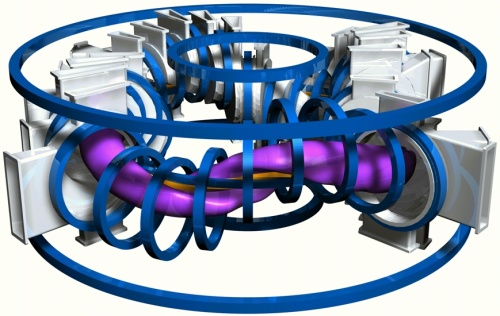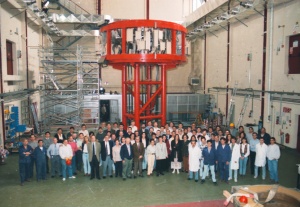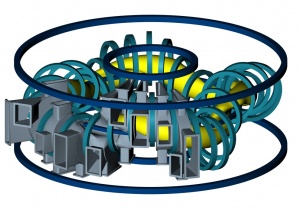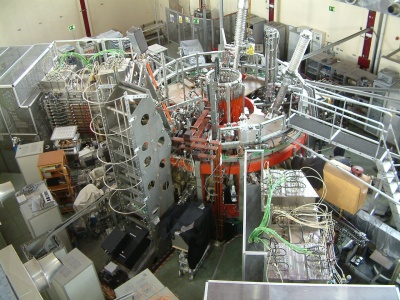TJ-II

TJ-II is a flexible Heliac installed at Spain's National Fusion Laboratory. It is one of Spain's Large Scientific Installations. It is currently operational.
History

The flexible Heliac TJ-II was designed on the basis of calculations performed by the team of physicists and engineers of CIEMAT, in collaboration with the Oak Ridge National Laboratory (ORNL, USA) and the Institut für PlasmaPhysik at Garching (IPP, Germany). [1] The TJ-II project received preferential support from Euratom for phase I (Physics) in 1986 and for phase II (Engineering) in 1990. The construction of this flexible Heliac was carried out in parts according to its constitutive elements, which were commissioned to various European companies, although 60% of the investments reverted back to Spanish companies.
The first plasma was produced in 1997.
Precedents
TJ-II is the third magnetic confinement device in a series. In 1983, the device TJ-I was taken into operation. The denomination of this device is due to the abbreviation of "Tokamak de la Junta de Energía Nuclear", this being the former denomination of CIEMAT. The abbreviation was maintained for successive devices for administrative reasons.
In 1994, the torsatron TJ-IU was taken into operation. This was the first magnetic confinement device entirely built in Spain. Currently, TJ-IU is located at the University of Stuttgart in Germany under the name of TJ-K (the 'K' stands for Kiel, its first location in Germany, before arriving in Stuttgart).
Description

In TJ-II, the magnetic trap is obtained by means of various sets of coils that completely determine the magnetic surfaces before plasma initiation. The toroidal field is created by 32 coils. The three-dimensional twist of the central axis of the configuration is generated by means of two central coils: one circular and one helical. The horizontal position of the plasma is controlled by the vertical field coils. The combined action of these magnetic fields generate bean-shaped magnetic surfaces that guide the particles of the plasma so that they do not collide with the vacuum vessel wall.
TJ-II discharges last around 0.25 s, with a repetition frequency of about 7 minutes.
| Parameter | Value | Unit |
|---|---|---|
| Major radius, R0: | 1.5 | m |
| Minor radius, a: | < 0.22 | m |
| Plasma volume, V: | 1 | m3 |
| Field periods: | 4 | |
| TF coils: | 32 | |
| Number of ports: | 104 | |
| Rotational transform, ι/2π: | 0.9 - 2.5 | |
| Magnetic field on axis, B0: | ~1 | T |
| ECRH heating power, PECRH: | < 600 | kW |
| NBI heating power, PNBI: | < 2 | MW |
| Pulse length: | < 200 | ms |
Goals and Research
The objective of the experimental program of TJ-II is to investigate the physics of a device with a helical magnetic axis having a great flexibility in its magnetic configuration, and to contribute to the international effort regarding the study of magnetic confinement devices for fusion.
Also refer to LNF:Plasma Physics.
Operation
- A vacuum system controls the pressure inside the vacuum vessel.
- The electric energy required for a TJ-II discharge is obtained from a flywheel generator.
- The coils are cooled by means of a cooling system.
- An extensive set of systems is available to perform plasma wall conditioning.
- Two movable limiters can be used to limit the plasma.
- A biasing probe can be used to apply a bias potential at the edge.
- A mechanical paddle is used to suppress runaway electrons during current ramp-up and ramp-down.
Heating and fuelling
In order to fuel and heat the TJ-II plasma, the following systems are used:
- Gas puff
- Electron Cyclotron Resonant Heating (ECRH)
- Neutral Beam Injection (NBI)
- Electron Bernstein Wave Heating (EBWH)
- Pellet injector (PI)
Control and data acquisition
The Control and data acquisition systems were designed end developed at CIEMAT.
Diagnostics

TJ-II is fitted with an extensive set of diagnostic systems installed in its 96 access ports. For information on the magnetic coordinate system (required for cross-diagnostic comparisons), see TJ-II magnetic coordinates.
Passive diagnostics
- Magnetics
- Halpha monitors
- Electron Cyclotron Emission
- Soft X-rays
- Multifilter electron temperature diagnostic
- Bolometry
- Spectroscopy
- Charge exchange spectroscopy
- Compact Neutral Particle Analyzer
- Fast ion loss probe
- Fast camera
Active diagnostics
- Interferometry
- Reflectometry
- Heavy Ion Beam Probe
- Langmuir Probes
- Thomson Scattering
- Diagnostic neutral beam
- Helium Beam
- Lithium Beam
Interactive on-line data visualization
Numerical resources
Simulation codes
- VMEC - 3D Plasma equilibrium, assuming nested flux surfaces
- PIES - 3D Plasma equilibrium
- HL - Field line following code
- ASTRA - Plasma transport
- PROCTR - Plasma transport
- EUTERPE - Gyrokinetic code
- EIRENE - A Monte Carlo neutral gas transport code
- FAFNER
- CUTIE - Full-tokamak fluid turbulence
- MOCA - Monte Carlo Neoclassical transport code
- DKES - Neoclassical transport code
- TRECE - Microwave ray tracing
- TRUBA- Microwave beam/ray tracing including electron Bernstein wave calculations.
Data analysis
- Wave_ana - Linear and non-linear data analysis, spectral analysis using Fourier and Wavelets
- EBITA - Tomographic reconstruction
- Tomography - Tomographic reconstruction based on mode decomposition in flux surface geometry